Know how to deal with sleepwalking or somnambulism
Sleepwalking or somnambulism is a disorder in behavior that originates during deep sleep and this can result in walking or doing other complex behaviors while asleep.
This disorder occurs most often to children than adults. Those who are sleep deprive also has greater possibility of having this.
Sleepwalkers are difficult to awaken and most probably does not remember the somnambulism incident.

Somnambulism is not just mere walking during sleep but it also involves a series of complex of behavior which are carried out while asleep.
Here are the symptoms of sleepwalking
- Sleeptalking
- Little or no memory of the event
- Difficulty arousing the sleepwalker during an episode
- Inappropriate behavior such as urinating in closets (more common in children)
- Screaming (when sleepwalking occurs in conjunction with sleep terrors)
- Violent attacks on the person trying to awaken the sleepwalker
Dealing with somnambulism
There is no specific treatment form this disorder but improving sleep hygiene can help a lot. Consulting a doctor or sleep specialist is also a big factor in dealing with somnambulism.
Those who experience this disorder should be ready to open up about fatigue, medication, or stress, which may trigger symptoms.
For younger somnambulist, doctor’s expertise must be consulted when the child continue experiencing the symptoms until adolescence.
Doctors often do hypnosis when in comes to adult sleepwalkers. Pharmacological therapies such as sedative-hypnotics or antidepressants can also help.
How to cope?
Increasing the amount of time scheduled for sleep can help dealing with sleepwalking. There are times that somnambulism can be triggered by alcohol and certain medications.
It is also helpful to create a safe sleep environment in order to be prepared for the sleepwalking episodes.
For children, don’t let them sleep in bunk beds and be sure to remove sharp and breakable objects around them.
READ ALSO: Insomnia Attack: Things To Do When You Can’t Sleep
